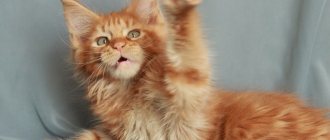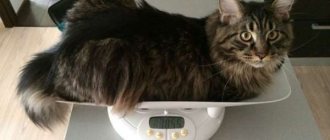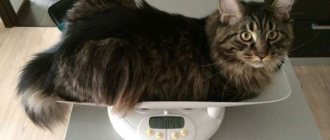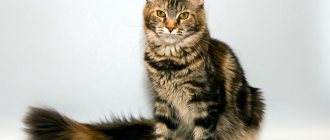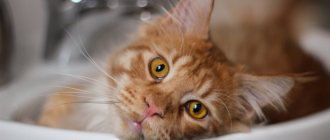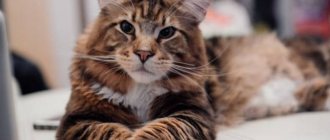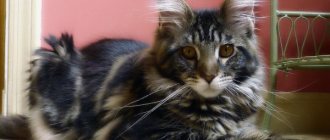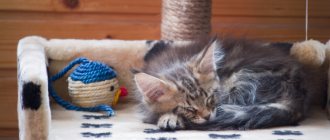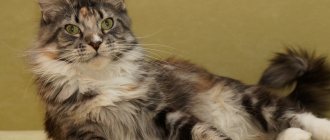Maine Coon real weight.
Maine Coons
- magnificent and beautiful large-sized domestic cats. Anyone who has seen a cat of this breed knows that these animals are quite massive, and of course the most burning question that interests visitors to exhibitions, Internet sites, potential or young Maine Coon owners is how much does a Maine Coon cat weigh? Very often you hear stories about gigantic Maine Coons weighing 15-25 kg. And once again I hasten to convince you that this weight does not exist in cats of this breed, it is a legend. The average weight of a Maine Coon is: 4-7 kg for cats, and 8-10 kg for males. The Maine Coon cat can easily reach one meter in length (from the tip of its nose to the tip of its tail).
The Maine Coon seems so big not only because it has an impressive weight, the Maine Coon cat, unlike cats of other breeds, has a long elongated body with good impressive muscles, strong powerful paws, a large head, a massive neck and a “shoulder girdle”, so the cat The Maye Coon breed can produce a stunning impression of a very massive animal weighing 15 kilograms or more, with the real weight of the Maine Coon being 8 kg and most importantly, there is no dependence on the place of residence of the Maine Coon and its weight, no matter where your Maine Coon grew up in the city. Moscow or St. Petersburg, Orenburg, Kirov, Saratov, Samara or in distant Salekhard, Kemerovo or Khabarovsk, the place of development and growth of the Maine Coon does not affect the genetics, and as a result, the weight of the Maine Coon - I think everyone understands this.
Weight and development of Maine Coon kittens from birth to maturity.
Maine Coon kittens are born much larger than kittens of other cat breeds. For example, a Maine Coon kitten at birth has a body weight of 120-170 g, and kittens of the same Persian breed are born weighing 80-120 g. If we take the average statistical figures, then Maine Coon kittens are born at 120-140 g. An important factor influencing the weight of a Maine Coon kitten at birth is the size of the litter in which the kitten was born, again let’s look at an example, if there were 5 kittens in the litter, then The average weight of a Mei Coon will be 125-130 grams. If only one baby was born in the litter, then the Mei Coon kitten can be quite large and weigh 145-160 grams. This is the order of the numbers.
I would also like to note that various factors influence the growth of a kitten.
Genetic factors that influence the development and weight of the Maine Coon.
1. Maine Coon breed. The growth rate of a kitten depends on its mass, determined by the characteristics of the breed. The greater the mass according to breed characteristics, the higher the growth rate. 2. Gender As kittens grow older, there is a difference in the rate of weight gain. For example, by 10-12 weeks, Maine Coon males become much heavier than females. 3. The weight of the mother cat Mei Coon. This parameter depends on the breed and genotypes of the parents. The more massive the cat is, large, and in good physical condition, the higher the growth rate of Mei Coon kittens. Individual genetic factors. The combination of parental genotypes leads to the appearance of a unique organism. This uniqueness is also manifested in the development of the skeletal and muscular systems and the different growth rates of animals. 4. Hormonal factors. The use of hormonal drugs for therapeutic purposes can lead to endocrine imbalance in a Maine Coon kitten, which will negatively affect growth.
External factors influencing the development of the Maine Coon and the weight of the kitten.
1. The sanitary and hygienic condition of the place where the kittens are located.
2. Stress factors. Hormones produced under stress can have a strong effect on the endocrine system, resulting in impaired growth. Maine Coon cats and kittens must be protected from noise, changes in air temperature and other unfavorable factors.
3. Feeding the mother cat. Adequate feeding of a Maine Coon cat during pregnancy is a necessary condition for the growth of the weight of newborn Maine Coon kittens and their viability.
A newborn healthy Maine Coon kitten should normally gain an average of 10 g per day. If there is a slight loss of Maine Coon weight, then this is possible in the first phase of growth. If a Maine Coon kitten does not gain weight for 2 days in a row, you need to pay attention to this and start taking appropriate measures: complementary feeding, vitamins, homeopathy. It is not at all necessary to artificially feed the kitten all the time before switching to regular food; perhaps the kitten will only need a few days of artificial feeding to gain the missing weight for the kitten and regain strength. A Maine Coon kitten increases its weight by 2 times by 10 days, 4 times by 4 weeks, 8 times by 8 weeks. The Maine Coon's peak growth occurs when its daily weight is at its maximum. The Maine Coon's peak growth occurs between 4 and 5 months. This period is characterized by the highest energy needs of the animal.
Periods of Maine Coon development and the weight of a Maine Coon kitten.
From birth to peak growth, the development of Mei Coon kittens is divided into several periods: 1. Neonatal period. Lasts about 4 days. Daily weight gain varies greatly depending on how the birth went. 2. Sucking period. 4 weeks of life. Characterized by stable, uniform growth. The average daily weight gain of a Maine Coon kitten is 20-50 g. By 4 weeks, leveling occurs and possible intrauterine underdevelopment of the fetus is compensated. The weight of a Maine Coon kitten at 1 month is 500-800 g. At 2 months – 900-1500 g. 3. Transition period. From 4 to 7 weeks. At this stage, the type of feeding the kitten changes. By 3-5 weeks, weight gain slows down in the Maine Coon. This is due to the transition to solid food. By the 7th week, the growth curve goes up again, as the final transition to solid feed occurs. They contain all the necessary minerals and vitamins, so the animal’s weight begins to increase again. 4. After the suckling period. This is the beginning of the kitten’s independent life, from 7-8 weeks until the end of growth.
Maine Coon weight from birth to 3 years of age
Maine Coon weight 1 week (7 days)
The weight of a Maine Coon cat is from 240 to 260 g. The weight of a cat is from 240 to 280 grams
Maine Coon weight 2 weeks (14 days)
The weight of a Maine Coon cat at 2 weeks ranges from 340 - 400 grams. A Maine Coon cat weighs 350 - 420 grams at 2 weeks.
Maine Coon weight 1 month (4 weeks)
The weight of a Maine Coon cat at 1 month is approximately 560 - 740 grams, and a Maine Coon cat at 1 month weighs about 630 - 820 grams.
Maine Coon weight at 2 months (6 - 8 weeks)
The weight of a make-coon cat is 1,150 kg - 1,400 kg, and the weight of a cat is from 1,230 - 1,500 kg.
Maine Coon weight at 3 months (10 - 12 weeks)
The weight of a Maine Coon cat is 1.7 - 2.3 kg, and the weight of a cat is from 1.8 to 2.3 kg.
Maine Coon weight at 4 months (14 - 16 weeks)
Typical weight standards for cats and Maine Coon cats
All professional felinologists advise carefully monitoring how the kitten gains weight. And even after he reaches the age of one and a half years, one should not forget about periodic monitoring of the weight of an already adult cat. Since most often, even small deviations from the norm of a particular age of an animal can indicate an incipient disease. In this case, urgently taken measures are much more productive than treatment in the later stages of the disease.
So, speaking about weight standards, according to the age of the kitten, you need to remember the following figures:
- at neonatal age, which is no more than 4 days from the birth of a small Maine Coon, the normal weight gain during the day should be about 10 grams;
- if a newborn baby does not gain, but rather begins to lose weight, urgent measures must be taken;
- the suckling period of a kitten's life (the first 4 weeks) is characterized by a daily more or less stable increase in body weight by 20, or even 50 grams;
- As soon as the pet is 1 month old, its weight should be 620-750 grams. for males and 100 gr. less for women's;
- during the transition to the adult type of feeding (from 4 weeks of age to 7 weeks of age), weight gain slows down slightly, but at the end of this period it stabilizes again and the weight of the cat should reach 1.3-1.5 kg, and that of cats - up to 1.1- 1.3 kg.
Then the independent, “adult” life of the newly-minted household member begins. By the way, I would like to note that weight indicators may vary with small errors, which in no way indicate a possible illness in the cat. Rather, they will demonstrate factors related to the living conditions and lifestyle of the Maine Coon, as well as dependence on the breed variety.
Upon reaching the age of three months, the weight of a female individual can grow up to 2 kg, and a male one – even up to 2.7 kg. For comparison, I’ll take six-month-old Maine Coons. Males at this age gain twice as much weight (4-6 kg), as do females. They weigh about 3.5-4.5 kg. Peak weight gain is observed at one to one and a half years of age. The body weight of an adult, respectable cat during this period of time can reach up to 10 kg (lower threshold - 6 kg), and females - 6.5-7 kg (lower threshold - 4.5 kg).
Genetic factors
Let’s immediately say once again that this is a rather unusual cat - a Maine Coon. Kittens grow and develop depending on their weight, determined by the characteristics of the breed. The greater the weight according to breed characteristics, the greater the growth rate of the animal.
The second reason why the weight of a Maine Coon varies from month to month is gender. For example, by 3 months, males gain much more weight than females.
The third factor can be called the weight of the mother cat. This parameter depends on the genotypes of the parents. The larger and physically healthier the cat, the faster the kittens will grow.
Individual genetic characteristics. Any combination of parental genotypes leads to the emergence of a unique, new organism. This is manifested in the development of the muscular and skeletal systems, as well as in the growth rate of kittens.
Hormonal factors. This refers to the use of various hormonal drugs prescribed for therapeutic purposes. Uncontrolled use of this group of drugs or changes in prescribed dosages may disrupt the imbalance in the kitten’s endocrine system, which will subsequently negatively affect its growth and development.
What can you do if your little Maine Coon is not gaining weight?
As I noted earlier, as soon as the first signs of weight loss in newborn kittens appear, it is necessary to urgently contact specialists. Sometimes this is a completely unworthy indicator. It’s just that a difficult birth of a mother cat could provoke a stressful state of the kitten and in a few days, as soon as the cat returns to normal, the baby’s health will also normalize. And he will slowly begin to make up for lost grams.
However, more often in such cases, doctors advise feeding the little patient a little and prescribing complex therapy:
- vitamins to maintain energy balance in the body;
- homeopathic remedies to relieve stress;
- auxiliary feeding to replenish the missing substances that for some reason do not enter or are not absorbed in the kitten’s body.
If the cat that gave birth to small Maine Coons is small in size, then the kittens can take much longer to gain height and weight. In this sense, it is much easier for large individuals. Kittens from such cats are initially born with good body weight, which allows them to quickly gain the necessary grams.
Kitten weight by month
A newborn kitten weighs from 60 to 70 g; it is not able to move independently or even stand on its paws. Kittens should be placed in a box with several layers of diaper to keep the kitten warm and cozy.
It is advisable to place the kittens’ habitat in a secluded place with high sides so that they cannot get out and damage themselves.
Kittens should be weighed every day and their weight recorded in a log to track at what point the kitten stops gaining weight or when it decreases.
In general, weight gain can reach up to 20 g or even more, but this is more likely to be observed in large breeds/Yandex Collections
A few days after the birth of the baby, you need to pay attention to the fact that the kitten’s navel should fall off and pus should not form in its place.
Afterwards the animal begins to open its eyes, from about 7 to 14 days. At approximately 4 weeks of age, the first complementary foods can be introduced. This will make the mother’s life much easier and will prevent particularly small and weak kittens from dying.
It is recommended to use high quality pate or ground low-fat meat.
If a one-year-old or older Maine Coon suddenly begins to lose weight
For males and females of the Maine Coon breed, weight standards are no less important than for other representatives of the cat family. You can quickly find your way around them if you suddenly see signs of an obvious illness in your pet. And here it is important to get your bearings in time. Don't let the weight loss process take its course. The reasons for such a decrease in body weight in fully grown cats may be of the following nature:
- sudden change in diet or regimen;
- unbalanced diet;
- parasites and diseases caused by them;
- differences by gender (adult cats gain weight more slowly than males);
- genetic abnormalities;
- hormonal imbalance in the body;
- failure to comply with sanitary and hygienic standards for keeping furry pets;
- a sudden or constant external influence that causes the cat to experience severe stress or repeated stressful conditions.
As soon as you notice that your Maine Coon is not gaining weight, the first thing you should pay attention to is the diet, routine, nutritional balance and the presence of a stress factor. If there have been no sudden changes in diet recently, or stress, then you should immediately take your cat for examination. However, we should not forget that uncastrated and unsterilized male cats begin to eat poorly at certain times of the year and, as a result, lose weight. This factor should also be taken into account before engaging in self-hypnosis about a possible “terrible” illness in your cat.
The weight of a cat depends on age, gender, breed, and the presence of nutrients in the food. An adult yard cat weighs no more than 5 kg, but if the cat is Scottish, then its weight reaches 7 kg or more, a Maine Coon cat weighs up to 10 kg or more. If the cat is young, then its weight can change dramatically, increasing or decreasing depending on its lifestyle: the more active the animal, the faster it sheds the kilos it has gained. In the body of older cats, fat accumulates at a slower rate, so cats over 9 years old look thin. Below we will discuss why the cat is thin, and whether this is really dangerous for his body.
How much weight can an animal grow to?
The average weight of the animal is from 6 to 8 kg. Neutered dogs can grow up to 9-10 kg, sometimes the weight can exceed these figures. Some people are convinced that this is very little for this breed.
It is necessary to ensure that the animal does not gain excess weight. Otherwise, your pet will experience problems with the heart and blood vessels.
Maine Coon should not gain excess weight/Yandex Collections
Obesity for the Maine Coon is also dangerous because this breed has serious diseases associated with the joints, and if the cat stops leading an active lifestyle, the disease can overtake it by surprise.
Or, on the contrary, reduced weight, which is a greater danger for Maine Coons. Since their stomach is very sensitive, they should be fed only high-quality food or natural food of high quality.
Constant diarrhea, diarrhea and vomiting negatively affect the health and weight of the animal.
Signs of exhaustion
When wondering why a cat is thin, and whether this is normal, factors such as normal and painful thinness are taken into account. In the first case, we are talking about the weight standard that an animal of a particular breed must meet at a certain age. The second is about exhaustion. A cat that is too thin is most likely sick and requires long-term rehabilitation therapy, which can only be prescribed by a specialist.
Appearance standards for British breeds
Where to buy a kitten
Probably, it is not worth saying that it is under no circumstances worth buying a kitten of such a rare breed on the market. Buying a charming Maine Coon baby, the price of which is from 25 to 40 thousand rubles, is necessary only in a specialized nursery.
Today we introduced you to a rather rare breed of cat in our country. We found out how the weight of a Maine Coon changes over the months and what kind of care this animal requires. We hope that the information is useful to you and that you will have such a beautiful and very kind pet.
Normal thinness
A cat's weight has a lot to do with its age and breed:
- a domestic mongrel cat at the age of 1 year weighs from 2.5 to 4.5 kg (naturally, the figures may differ, but usually not significantly);
- a purebred cat at 1 year weighs from 3.5 to 5 kg;
- a cat of the British breed, reaching one year of age, weighs up to 4.5-4.6 kg;
- A British cat normally weighs from 4.5 to 7 kg, provided it receives the right amount of food.
Each of the existing cat breeds has its own weight table, which all animal owners must follow.
In a healthy cat:
- it is easy to feel the ribs and spine, but they are not visible from the side;
- there is a small amount of fat in the abdomen, back and chest;
- the waist line is clearly visible;
- the stomach does not sag, it is almost non-existent.
A cat can lose weight or gain weight while feeding or bearing kittens, and a cat during the mating period. This kind of thinness is considered normal. Sometimes an animal suddenly loses weight after experiencing stress (moving, a trip to the veterinarian). And that's okay too. If the kitten’s parents were not large or purebred, then you should not expect that after 1-2 years the pet will turn into a fat lazy cat, as in the picture in the advertisement.
Outbred cats are smaller and lighter than their purebred counterparts and even those animals that appeared as a result of crossing a purebred pet with a barn cat. The kittens will still be larger than those that an ordinary yard cat gives birth to, and accordingly, they will also weigh more.
Description of the breed
Large Maine Coons have a large body, wide neck and chest. The length of the tail of an adult animal is equal to half the length of the body. It is covered with long and thick hair. The head of this animal is large, the ears and cheekbones are high, the chin is pronounced, and there are often tufts on the ears.
The Maine Coon breed compares favorably with other felines with its large and very expressive round eyes. Their color can be yellow, amber, green or golden. Blue or cyan color is acceptable, but only for white cats.
Cats have thick hair that flows along the body, longer on the back, sides and belly. It is much shorter on the head and shoulders. The color can be any. Breeders managed to develop various shades and color combinations.
As already mentioned, there is a misconception that these beauties can reach gigantic sizes (up to 15 kg, and some indicate a weight of 25 kg). In fact, the weight of a healthy animal of this breed is no more than 12 for males, and females weigh about 8 kg. The growth of cats is usually measured not in height, like other animals, but in length. On average it reaches 100 cm.
There are many characteristic signs by which Maine Coon animals can be distinguished. Kittens are born much larger than babies of other species. For example, a newborn of this breed weighs 120-170 g, while kittens, for example, “Persians” (not the smallest) are born with a maximum weight of 120 g.
If we take average numbers, then the weight of Maine Coon kittens at the time of birth is 120-140 g. An important factor influencing the baby’s weight is the size of the litter in which he was born. For example, if 5 babies were born, then the average weight will be 125 g. If only one baby is born, then the kitten’s weight will significantly exceed the average. Such a baby can weigh 145-160 g.
It is important to know that the growth and development of a kitten is influenced by different aspects - both natural ones, which we cannot influence, and everyday ones, which the owner can correct. Let's consider them further.
When is it time to sound the alarm?
Cats begin to worry about being thin if:
- the cat eats a lot and often, but does not gain weight, it is too light and small for its breed (thin cats do not gain weight);
- the spine can be traced visually (the ridge literally protrudes outward);
- the pelvic bones and ribs protrude, their movement is clearly noticeable when the cat moves;
- the cat’s breath smells unpleasant (obviously, the gastrointestinal tract is disrupted, the kidneys and liver are not functioning properly, plaque or caries may have formed on the teeth);
- there is no fat layer on the chest and back area, only bone;
- the cat does not show usual attention to toys, sleeps constantly;
- the animal has loose stools (if mucus, blood, or undigested parts of food are found in the stool, consult a doctor);
- yellowness or excessive pallor of the mucous membranes is observed, they become gray in color (most likely, weight loss is due to problems with the liver and kidneys);
- more fluid is released from the eyes, nose and mouth than usual, especially when an unpleasant odor appears, a change in the color of the animal’s tears and saliva;
- the temperature rises (hot nose, the cat is lethargic, to check the temperature it is enough to use a regular thermometer);
- the stomach is sunken, hard, tense.
The silhouette of an emaciated cat resembles an hourglass.
When the described signs appear, the animal is weighed (to do this, just place it in a bag and use a steelyard or in a cardboard box, cover the top with something and put it on a regular floor scale).
If the cat always eats well, but is very thin, weighs 1 kg or more less than it should, contact a veterinarian. It is first necessary to take weight measurements for several weeks in a row to make sure that there really is a reason for concern (cats are thin and do not gain weight for various reasons, but most often due to illness).
Why doesn't a castrated cat get fat?
There is an opinion among owners of cats that have not yet been neutered that as soon as castration occurs, absolutely everything in the character, lifestyle and behavior of the animal will change. Cats become calm and even lazy, stop marking, and begin to quickly gain weight. In relation to probably 70-80% of castrated animals, this opinion is justified, since it is based on the knowledge that after the procedure the hormonal levels change, the cat’s metabolic processes slow down, which means it becomes less energetic. But this doesn't always happen.
Note! If the animal was neutered late, at 1.5-2 years, then there is a high probability that there will be no sudden changes, so the sight of a skinny cat should not be alarming.
Causes of exhaustion
Exhaustion, or cachexia, develops under the influence of exogenous (external) and endogenous (internal) factors.
Exogenous
Exogenous external causes of exhaustion include:
- lack of food (emaciation is observed in feral cats and animals that receive food from time to time);
- impaired swallowing functions (the cat has something stuck in its throat, the nasopharynx is inflamed due to an insect bite, under the influence of allergens);
- problems with teeth (inflammation in the oral cavity, caries, tartar - all this prevents the animal from eating its usual food).
Natural Cause of Thinness
An adult cat should receive at least 70 g of dry food per day. If the cat is nursing offspring or is sick, the norm is doubled. At the same time, there should always be only fresh food in the bowl, as many food manufacturers warn about.
Endogenous
Endogenous (internal) factors that provoke cachexia include diseases of a non-infectious and infectious nature. Cats lose weight due to the development of:
- oncological diseases;
- cardiovascular pathologies;
- diabetes mellitus;
- chronic infections (infectious peritonitis, immunodeficiency, leukemia).
Cachexia is caused by hormonal disorders, problems with the pancreas, dysfunction of the kidneys, liver, and pituitary gland.
Sometimes weight loss occurs due to:
- the occurrence of a stressful situation (if the cat is given into the wrong hands, often transported);
- bearing offspring and feeding kittens (nursing cats often become excessively thin, so that a thin cat does not become completely exhausted and gets sick, kittens are weaned as soon as they begin to feed on their own);
- vitamin deficiency (feed must be balanced, it is useful to give the cat additional vitamins);
- formation of hairballs in the stomach (from time to time pets are given special tablets to cough it up);
- infection of the pet’s body with helminths (parasites release dangerous toxins, weaken the cat, their activity over time leads to physical pain, which causes apathy and loss of appetite).
An adult, non-castrated cat loses weight when the heat begins. In the spring, cats literally forget about everything in the world, including food, they move a lot and eat poorly, so they lose weight. Females also lose weight for this reason, but it is males who experience significant changes.
Important! Older cats move less, sleep a lot and, accordingly, eat less, which affects their body weight.
What should you not feed?
A number of foods are prohibited for this breed.
- Poorly digestible meat and poultry - pork, fatty lamb, goose, duck.
- Almost all fish. In nature, coons do not eat fish, so their digestive system is not adapted for such food.
- Bones. A cat can harm itself with sharp fragments of bird and fish bones.
- Sugar in any form disrupts metabolism.
- Salt and spices damage the stomach as they are not digested and can lead to the formation of kidney and liver stones.
- Boiled and smoked sausages, canned food. Contains many harmful additives.
- Potatoes, peas and other legumes. Causes bloating and disrupts digestion.
Some tips
Maine Coons are fed food at room temperature, which should be slightly warmed up. Up to two months, kittens are given food 5-6 times a day, gradually reducing (as they grow) the number of feedings and increasing the portion size. Adult pets are fed morning and evening. A balanced food contains at least 40% protein, 30% fat and 2% fiber. An adult cat can eat up to 500 grams of food per day.
What to do if the cat becomes thin
If the owner has changed several types of food and given the animal an anti-worm medication, and the kitten is thin and continues to lose weight, contact a veterinarian. He will conduct the appropriate diagnostics (the animal’s blood and feces are taken for analysis, the cat is given an ultrasound, its organs are x-rayed, a laparotomy is performed) and will advise how exactly the pet should be treated.
Treatment
The animal is treated based on the diagnostic results. To begin with, in order to restore normal body weight and support the body, the following are prescribed:
- infusion therapy. Its essence boils down to the artificial introduction into the body of an animal of a medicinal solution or biological fluid - blood, plasma. Method of administration: intravenous or subcutaneous. Treatment allows you to replenish the loss of plasma or blood, the lack of individual elements, restore the balance of electrolytes and maintain the acid-base balance. This type of therapy is prescribed to animals whose kidney function is impaired, blood poisoning has been detected, and there are all signs of severe shock. During treatment, the cat's weight is measured regularly;
- intravenous nutrition. Nutrients are administered intravenously if the animal is unable to eat food on its own. The mixtures used completely replace natural food, preventing the cat’s body from weakening. Food is also administered through a nasogastric tube.
Simultaneously with maintenance therapy, measures are taken to eliminate the problem. So, if the cause lies in an upset stomach, then the cat is given medications that help eliminate inflammation of the mucous membranes and relieve pain. If the reason for thinness is that there is a foreign object in the animal’s mouth, surgery is performed. If the cause of exhaustion is worms, then the specialist will prescribe a course of medications to remove them from the body as carefully as possible.
Important! You should not try to cure a cat on your own, since even a specialist with modern equipment at his disposal is not always able to make an accurate diagnosis. If a cat's body is heavily infected with worms, then using anti-parasite medication can cause its death. To prevent this from happening, the animal is placed in a hospital and given only dosed medications.
External factors
The sanitary and hygienic condition of the nest where the kittens live. Stress factors. They are produced under stress. Hormones have a negative effect on the baby’s endocrine system, and as a result, growth disturbance occurs. Therefore, nursing cats and kittens should be carefully protected from stress.
It is not necessary to artificially feed the kitten until the transition to a regular diet; it is likely that he will only need a few days of complementary feeding to regain the lost weight.
Maine Coon kittens are charming and very interesting soft balls that amaze with their beauty, confidence, restraint and strong character, despite their tender age. Although, most likely, even beauty alone is enough to fall in love with this breed.
Many owners of these animals know how rapidly the weight of a Maine Coon changes from month to month. Very quickly, fluffy balls turn into smart, strong animals who love fun and games. They get used to new surroundings very easily, get along well with their owners (especially children), and do not require complex care.
